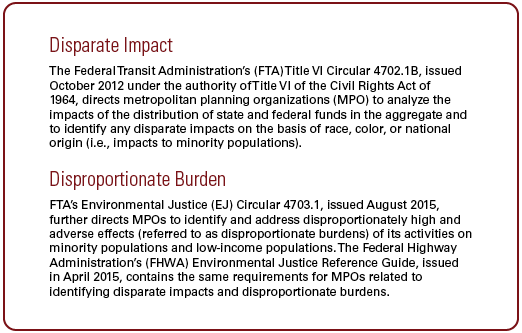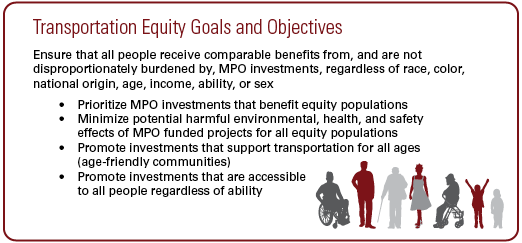In the last year, increased attention to systemic racism has deepened the mainstream conversation about transportation equity. Many Black transportation planners have pushed the field to recognize that emphasizing enforcement in Complete Streets or Vision Zero paradigms can put people of color at risk of violence. Similarly, the COVID-19 pandemic has laid bare the intersection of systemic health inequality and transportation planning. The incidence of chronic respiratory disease in communities of color, exposure to harmful emissions, and high rates of COVID infection and death are all intertwined legacies of highway-focused planning in the United States and the Boston region.
The federal transportation planning process was not designed to directly address the deep nuances of these issues. Most of the regulations that guide MPO efforts in this area come from civil rights and nondiscrimination laws like the Civil Rights Act of 1964 and the Environmental Justice Executive Order. These laws are important standards for protecting rights, but they do not necessarily capture the everyday lived experiences of people, nor are they designed to redress historical harm. Rather, these laws focus on preventing future discrimination, whether intentional or not. For the most part, MPOs are left to decide how best to reach beyond federal requirements to incorporate equity in ways that make a tangible difference in the lives of people living in their communities. MPOs must also decide whether to take on the task of attempting to correct past injustices in their policies.
Two recent efforts at the Boston Region MPO attempt to explicitly institutionalize equity into project funding in different and specific ways: the endorsement of a Disparate Impact and Disproportionate Burden (DI/DB) Policy, and revisions to the criteria used to select projects to fund.
Understanding the Impact of Project Funding
The federal government requires that the MPO show whether state and federally funded transportation construction projects in the MPO region, as a group, would likely disproportionately affect minority populations (called disparate impacts or DIs) or low-income populations (disproportionate burdens or DBs). The terms for minority and low-income populations are different because they come from different federal laws and regulations.

But what makes an impact disparate or a burden disproportionate? And how do you measure those impacts and burdens in a way that reflects a person’s lived experience? To answer these questions, the MPO took part in several rounds of stakeholder outreach and technical analysis starting in 2018. Stakeholders from around the region helped MPO staff identify specific measures that reflect transportation burdens or benefits. For example, stakeholders identified access to jobs, retail, healthcare, and higher education as important measures of transportation benefit. MPO staff then took those measures and conducted a round of modeling exercises to find out when changes to those measures would represent a DI or DB.
MPO took part in several rounds of stakeholder outreach and technical analysis starting in 2018. Stakeholders from around the region helped MPO staff identify specific measures that reflect transportation burdens or benefits. For example, stakeholders identified access to jobs, retail, healthcare, and higher education as important measures of transportation benefit. MPO staff then took those measures and conducted a round of modeling exercises to find out when changes to those measures would represent a DI or DB.
Staff created a series of three thresholds that can be used to evaluate the projects in the region for DI/DBs. All three thresholds must be passed to identify a “DI” or a “DB.” These thresholds help account for uncertainty in the MPO’s modeling and among the different metrics.
The First Threshold: Baseline Uncertainty
The first threshold determines whether the impact (for instance, an increase in travel time) would actually be caused by the projects and not some other factor. This is called the “Baseline Uncertainty Threshold.” With the help of stakeholders, MPO staff decided that this threshold should allow for a moderate amount of uncertainty, meaning that there is a moderate possibility that the impact is the result of some other change and not the construction of the project. (An exact number is not specified because the level of uncertainty varies with each metric.)
caused by the projects and not some other factor. This is called the “Baseline Uncertainty Threshold.” With the help of stakeholders, MPO staff decided that this threshold should allow for a moderate amount of uncertainty, meaning that there is a moderate possibility that the impact is the result of some other change and not the construction of the project. (An exact number is not specified because the level of uncertainty varies with each metric.)
The Second Threshold: Practical Impact
Once MPO staff is reasonably confident that the impact is the result of the project, it needs to be  determined whether the impact is significant enough to affect peoples’ quality of life. Determining the meaning of significance was the subject of the Disparate Impact Metrics Study. The central research question of the study was “When is an impact significant?” For example, how much of an increase in carbon monoxide affects quality of life?
determined whether the impact is significant enough to affect peoples’ quality of life. Determining the meaning of significance was the subject of the Disparate Impact Metrics Study. The central research question of the study was “When is an impact significant?” For example, how much of an increase in carbon monoxide affects quality of life?
The study found that setting one value for a large group of people or a region, which is the case for the DI/DB Policy, ignores significant negative or positive impacts to portions of the population or region because it averages out the outliers. Because of this, MPO staff did not find a good reason to set the value for the second threshold above zero. By keeping the threshold at zero percent, the MPO will account for the variation of impacts across the region and avoid increases of harmful impacts in communities that are already experiencing burdens.
The Third Threshold: Disproportionality
The final threshold determines whether the impact would affect the minority or low-income population more than the nonminority or non-low-income population. The threshold is zero percent, which means that any difference between the two populations is considered discriminatory.
A milestone both at the MPO and among MPOs nationally, this policy will allow the MPO to identify potential DI/DBs in a transparent, rational, and consistent manner. The policy will act as a check to ensure that minority and low-income populations will not be disproportionately affected by regional transportation investments. It will also help the MPO to better understand the effects of its decisions and whether it is meeting its equity goals. However, the federal requirements for a DI/DB policy do not allow for several things: Since projects must be analyzed as a group and not individually, impacts are not assessed at the neighborhood or municipality level. This means that the policy does not capture the everyday experience of inequity on an individual level. It also does not address existing inequities either, as the policy is used to analyze proposed projects. Also, because the model is only sensitive enough to pick up impacts of projects that change capacity (for example, an additional travel lane or a new train line), the DI/DB Policy only applies to the larger-scale projects in the MPO’s twenty-year Long-Range Transportation Plan (LRTP).
However, just because this specific federal requirement does not address those needs, it does not mean the MPO cannot address them in other ways. Beyond simply checking the box on federal requirements, the MPO’s stated goals for transportation equity include prioritizing projects that benefit the people and communities that have been disproportionately burdened by transportation projects. Specifically addressing these historical and existing inequities at the project level was the subject of last year’s effort to revise project evaluation criteria.

Prioritizing Equity through Project Selection
The DI/DB policy acts as a check on proposed projects as a group. To ensure that the MPO is actively funding projects that benefit equity populations, it needs measures that encourage project proponents to design projects that do just that. During 2019 and 2020, MPO staff worked to reimagine the criteria the MPO uses to select projects to fund in the Transportation Improvement Program (TIP).
Like the DI/DB policy process, MPO staff conducted public outreach to identify the impacts the criteria should measure. After coming up with a preliminary list of criteria based on this input, staff conducted a second round of outreach to ask the public to react to the list and propose any changes. On October 1, 2020, the MPO endorsed the new criteria.
Unlike the MPO’s criteria that measure things like safety and capacity management and mobility, the equity criteria evaluate both what the impacts of a project will be and who will be affected. This process awards points to projects that are near high percentages of equity populations and provide benefits to those communities.

Conversely, projects that have high percentages of equity populations near the project area, but would ultimately cause harm would lose points. In other words, projects do not receive points for equity just because they are near equity populations. The projects must actively improve transportation for those communities. Overall, these changes will help the MPO better address inequities in the region’s transportation system by ensuring that projects that serve marginalized groups are prioritized in project selection.
What Comes Next?
With the new DI/DB Policy and changes to the TIP criteria approved, the MPO is set to prioritize projects that benefit the region’s most vulnerable and underserved residents in a way that it has not done before. The new TIP criteria are currently being used to evaluate projects that cities and towns have submitted to the MPO for possible funding in the federal fiscal years 2022–26 TIP, which will be adopted in May. The DI/DB Policy will be used to help choose projects to fund in the MPO’s next LRTP, which is entering development now and will be adopted in 2023.
To learn more, visit the DI/DB Policy webpage and the Creating New TIP Criteria guidebook. To keep informed about upcoming presentations and upcoming MPO discussions about selecting projects to fund, subscribe to the mailing list and follow @BostonRegionMPO on Twitter, Facebook, and Instagram. If you are interested in learning more about equity at the MPO, contact Betsy Harvey Herzfeld, Transportation Equity Program Manager, eherzfeld@ctps.org.
